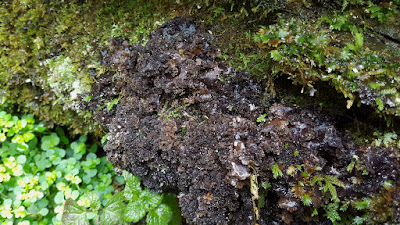Below are some images of two
Plagiochila samples collected on Monday, close to the second (new?)
Sticta canariensis site in the upper section of the gorge (main site shown above). Growing on a small dark cliff face, were scattered shoots of a tiny
Plagiochila that I took to be depauperate
spinulosa, as there were some nice patches of the latter only 1m away. However, as it shows a casual resemblance to
exigua, I thought pass it by for discussion / to highlight the potential for confusion.
First up, healthy
spinulosa specimens (note the long decurrent antical margin):
Now the troublesome specimen, associates including
Trichostomum tenuirostre, Heterocladium flaccidum, Lejeunea lamacerina, etc. (note the 'mostly short decurrent antical margin - but probably not as short as it should be, plus the leaves may be a bit too wide and broad-based?):
To get an idea of size, the following image shows a shoot along with
Heterocladium flaccidum, Lejeunea lamacerina and the
Trichomanes speciosum gametophyte:
Location of the diminutive
Plagiochila, it being more well-tucked in than the image might indicate:
Plus the reason for me being at this lovely site, the cyanobacterial morph of
Sticta canariensis:










That does look an awful lot like P exigua. The leaves look squarer than P spinulosa. Another option is depauperate P puncata, and I have a nagging doubt that's what I called similar plants in the ravine when I visited in 2001ish. I have no concerns about two Plagiochila spp growing in close proximity, with one exploiting a more constantly humid microniche. This would be the southernmost P exigua in Britain. Perhaps you could send the specimen to an independent expert for their ID view: Tim Blackstock or David Long perhaps? I can't make that ID because of sensitivities about the site.
ReplyDeleteThanks Sam, I'll send it off as you suggest and will report back...
ReplyDelete